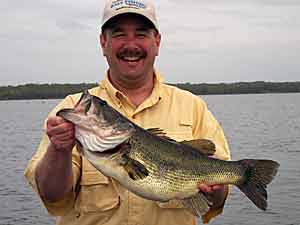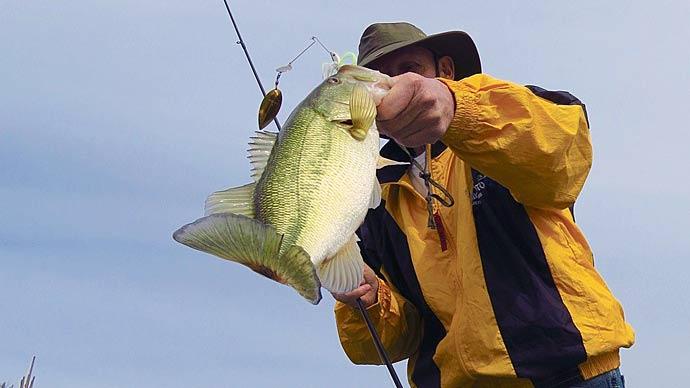
Weather trends will always affect fish movements and patterns, but there are fish in each lake that will be "catchable" most of the time. All you have to know is how to find and fish for them.
For many years anglers have relied on moon charts for major and minor feeding periods, and while these can offer some assistance, not all bass will feed during these periods. Evidence of this was first noticed while tracking a 10-pounder at Sam Rayburn (Texas). We called her Samantha.
When I tracked this fish, she grew to about 13 pounds. She lived in some pretty extreme conditions at Sam Rayburn. The lake's water level at that time fluctuated from 13 feet low during the summer to three feet above normal pool next spring.
The water level is one of the first things that usually move fish from normal patterns. With water level changes, sometimes there are coloration changes. The water will become muddy or clearer. These changes occurred in Samantha's regular territory, yet she remained. She would suspend at about 10 feet over a ledge that dropped from 15 to almost 30 feet. There was no cover in the area, no weed lines, no stumps, nothing visible that would hold her there. But stay she did. And she wasn't alone. There would always be several other fish about her same size right there with her.
One day as I was tracking Samantha, I watched the time for the next major feeding period to see if she fed at that time. From about 1:55 in the afternoon until nearly 4:00, the major feed, according to the moon charts, she became active and appeared to be feeding on schedule. She did so almost daily according to the times she was supposed to by the charts.
However, at Lake Fork, only a few days later, while tracking another fish - this one about 12 pounds - I tracked the fish for several days, and not once did it feed during a major period, according to the moon charts. This fish ceased to feed at all during the major times. This was not the first time I had encountered this situation.
I believe that the moon charts are helpful to an extent, but bass being typically unique in their habits - particularly larger bass, that is, those over seven pounds - you cannot use only the charts as a basis for your fishing times.
When a big bass has not been successful in its morning hunt, by mid-day, that fish will have to find food, whether it's a major feeding period or not. Bass are not 100 percent successful in their attempts to catch food but probably only manage to do so about 75 percent of the time. If they did not "go hungry," sometimes you would not be as likely to catch them on a lure. You are generally catching fish that are still hungry. Of course, there are the oddities among bass; the little gluttons you catch already have a belly full of shad. But larger fish tend to feed heavily and then rest for some time before feeding again. The small, younger bass mainly feed more often and for more extended periods.
By all means, use the moon charts to get some idea of when the fish should become active, but in between those times (major and minor), try slowing down your presentation. Experiment with other lures that you have not used that day. Making changes in your fishing tactics can mean the difference between a productive day and a poor one.
Fishing all across the state last year was a learning experience as our lakes suffered from an assortment of ills, from algae blooms in some to recovery from LMBV in others. These things, in conjunction with changing water levels and weather that was undoubtedly unpredictable, made for some tough fishing everywhere. No single area was immune to slow days. But like all the cycles of our planet, fishing will also cycle in again. Most lakes with problems have lots of little fish to replenish the resource, and time will make a difference.
Classic examples of cycles are obvious from fishing reports and tournament results from some lakes with average or decent fishing that went ballistic last year. Amistad, where fishing has always been relatively good, was producing some incredible fish. Yet it is not always so. Each lake will have some banner years and some poor ones. It's the same with deer hunting or any other sport where the creatures that rely on the resources to thrive or barely hang on are involved.
Along with using moon charts to predict potentially active periods for fish, you must also take the other factors of weather and water conditions to prepare for a successful fishing day.
Then, of course, you'll still have to throw in a moderate amount of good luck for it all to work.




